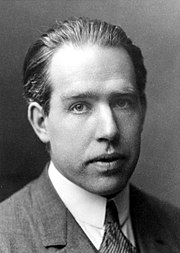Niels Bohr's Human Design Chart
6/2 Emotional Manifesting GeneratorDanish physicist who made foundational contributions to understanding atomic structure and quantum mechanics, for which he received the Nobel Prize in Physics in 1922. Bohr was also a philosopher and a promoter of scientific research.
Bohr developed the Bohr model of the atom with the atomic nucleus at the centre and electrons in orbit around it, which he compared to the planets orbiting the Sun. He helped develop quantum mechanics, in which electrons move from one energy level to another in discrete steps, instead of continuously. He founded the Institute of Theoretical Physics at the University of Copenhagen, now known as the Niels Bohr Institute, which opened in 1920. Bohr mentored and collaborated with physicists including Hans Kramers, Oskar Klein, George de Hevesy and Werner Heisenberg. He predicted the existence of a new zirconium-like element, which was named hafnium, after Copenhagen, when it was discovered. Later, the element Bohrium was named after him. He conceived the principle of complementarity: that items could be separately analysed as having contradictory properties, like behaving as a wave or a stream of particles. The notion of complementarity dominated his thinking on both science and philosophy.
During the 1930s, Bohr gave refugees from Nazism temporary jobs at the Institute, provided them with financial support, arranged for them to be awarded fellowships from the Rockefeller Foundation, and ultimately found them places at various institutions around the world. After Denmark was occupied by the Germans, he had a dramatic meeting in Copenhagen with Heisenberg, who had become the head of the German nuclear energy project. In 1943, fearing arrest, Bohr fled to Sweden, where he persuaded King Gustav V of Sweden to make public Sweden’s willingness to provide asylum. He was then flown to Britain, where he joined the British Tube Alloys nuclear weapons project, and was part of the British team of physicists who worked on the Manhattan Project. After the war, Bohr called for international cooperation on nuclear energy. He was involved with the establishment of CERN, and became the first chairman of the Nordic Institute for Theoretical Physics in 1957. He was also involved with the founding of the Risø DTU National Laboratory for Sustainable Energy.
His son Aage Bohr became a successful physicist and in 1975, like his father, was awarded the Nobel Prize in physics.
He died 18 November 1962.
Link to Wikipedia biography
Discover More Famous People
Browse and analyze over 55,000 public figures and celebrities.
Ra Uru Hu
5/1 Manifestor
Martha Stewart
4/6 Manifestor
David Lynch
4/6 Generator
Barack Obama
6/2 Projector
Steve Jobs
6/3 Generator
Vladimir Putin
5/1 Manifestor
Kim Kardashian
3/5 Generator
Michael Jackson
1/3 Projector
Marilyn Monroe
6/2 Projector
Ariana Grande
2/4 Projector
Oprah Winfrey
2/4 Generator
Johnny Depp
2/4 ManifestorWhat is HumanDesign.ai and how does it work?
Curious what makes Niels Bohr tick? HumanDesign.ai instantly maps their exact birth data into a fully interactive clickable bodygraph chart, letting you hover or tap every center, channel, and gate for plain-language explanations. Bella, the platform’s built-in AI guide, adds context in real time, translating complex mechanics into everyday insights so you can see how Niels Bohr’s strengths, challenges, and life themes play out on-screen.
The same tools are waiting for you. Generate your own Human Design Chart in seconds, open a library of 2000+ suggested questions, and chat with Bella as often as you like to decode your design, daily transits, and even relationship dynamics.
Want to compare energies? Save unlimited charts for friends, family, or clients, then ask Bella to reveal compatibilities, composite patterns, or coaching tips, all in one conversation thread.
Start free with core features, or unlock our Personal and Pro plans for deeper dives: unlimited Q&A, celebrity chart search spanning 55,000+ public figures, white-label PDF reports, branded content generation, and a professional profile with built-in booking for practitioners. Whether you’re exploring your own potential or guiding others, HumanDesign.ai delivers an ever-expanding toolbox of AI-powered insights—no spreadsheets, no jargon, just clarity at your fingertips.
Ready to see yours? Signup for FREE today!

